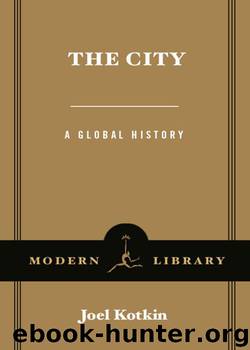The City by Joel Kotkin

Author:Joel Kotkin
Language: eng
Format: epub
Tags: History
ISBN: 9780307432049
Publisher: Random House Publishing Group
Published: 2007-12-18T05:00:00+00:00
“SHARPENING OUR AXES”
The Soviets had equally little reverence for the role of sacred place or the past in the evolution of cities. In short order, Nizhniy Novgorod became Gorky; Tsaritsyn was renamed Stalingrad; Yekaterinburg, where Czar Nicholas II and his family were liquidated, became Sverdlovsk, after another Soviet leader. In elegant, newly renamed Leningrad, the urban landscape became dominated by massive new housing blocs, office buildings, and commercial spaces designed in what one writer called “a ponderously neoclassical” style.43
Moscow underwent an even more dramatic transition. Joseph Stalin, a provincial from distant Georgia, displayed even less appreciation for urban values than Hitler, who had spent his formative years in Vienna and Munich, or the Japanese nationalists, who still revered aspects of that country’s urban past. To the horror of much of the architectural community, the Soviet dictator ordered the construction of a new Palace of Soviets—a monument to what Stalin called “the idea of the creativity of the multi-million Soviet democracy”—on the site of the city’s magnificent Cathedral of the Savior, a structure built with the pennies of Russia’s faithful.
Nikita Khrushchev, who eventually would follow Stalin as leader of the “Soviet democracy,” shared these less than delicate sensibilities. “In reconstructing Moscow,” he said in 1937, “we should not be afraid to remove a tree, a little church or some cathedral or other.”44 Khrushchev proceeded to destroy much of the old city, including its Triumphal Arch, its old towers, and its walls. When his own architects pleaded with him to spare historic monuments, he replied that his construction crews would continue “sharpening our axes.”45
The Communist drive to expand manufacturing capacity—by the 1930s, the Soviets had surpassed czarist industry by a wide margin—engendered an ambitious surge in town building. Magnitogorsk, rising adjacent to a giant iron and steel factory on the steppe, typified the new Soviet city: no mosques, churches, or free markets, a population of forced laborers driven by legions of zealous Young Communists. Like the victims of Britain’s early capitalist industrialization, the forced workers of the Socialist state endured wretched conditions, subject to epidemics of typhus, typhoid, and other infectious diseases.46
In one respect, Soviet urban policies did succeed: They utterly transformed a predominantly rural country into a largely urban one. By the 1930s, cities such as Moscow and Leningrad ranked among the largest in Europe; other smaller cities, particularly factory towns like Sverdlovsk, Gorky, Stalingrad, and Chelyabinsk, expanded even more rapidly. Between 1939 and 1959, the urban population of the Soviet Union grew by 30 million people, while the rural component dropped by 20 million. By 1960, 50 percent of Soviet citizens were city dwellers.47 There were also some notable accomplishments, such as the Moscow subway and major new electrification systems.
Download
This site does not store any files on its server. We only index and link to content provided by other sites. Please contact the content providers to delete copyright contents if any and email us, we'll remove relevant links or contents immediately.
| Anthropology | Archaeology |
| Philosophy | Politics & Government |
| Social Sciences | Sociology |
| Women's Studies |
Cecilia; Or, Memoirs of an Heiress — Volume 1 by Fanny Burney(32412)
Cecilia; Or, Memoirs of an Heiress — Volume 3 by Fanny Burney(31822)
Cecilia; Or, Memoirs of an Heiress — Volume 2 by Fanny Burney(31800)
The Great Music City by Andrea Baker(31249)
We're Going to Need More Wine by Gabrielle Union(18951)
All the Missing Girls by Megan Miranda(15489)
Pimp by Iceberg Slim(14318)
Bombshells: Glamour Girls of a Lifetime by Sullivan Steve(13950)
Talking to Strangers by Malcolm Gladwell(13185)
Norse Mythology by Gaiman Neil(13169)
Fifty Shades Freed by E L James(13145)
For the Love of Europe by Rick Steves(12638)
Mindhunter: Inside the FBI's Elite Serial Crime Unit by John E. Douglas & Mark Olshaker(9160)
Crazy Rich Asians by Kevin Kwan(9147)
The Lost Art of Listening by Michael P. Nichols(7388)
Enlightenment Now: The Case for Reason, Science, Humanism, and Progress by Steven Pinker(7162)
The Four Agreements by Don Miguel Ruiz(6597)
Bad Blood by John Carreyrou(6519)
Weapons of Math Destruction by Cathy O'Neil(6116)
